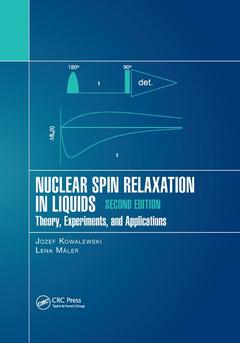Description
Nuclear Spin Relaxation in Liquids (2nd Ed.)
Theory, Experiments, and Applications, Second Edition
Authors: Kowalewski Jozef, Maler Lena
Language: English
Subjects for Nuclear Spin Relaxation in Liquids:
Keywords
Nitroxide Radical; Cross-relaxation Rates; NMR; American Chemical Society; Nuclear Magnetic Resonance; Extreme Narrowing Regime; NMR relaxation; NOE Cross-peaks; Long-lived NMR spin states; Spin Lattice Relaxation Rate; NMR spectroscopy; Rotational Correlation Time; NMR spin; Time Correlation Function; Kowalewski Jozef; NOESY Spectrum; Mler Lena; Anisotropic Chemical Shielding; Nuclear Spin Relaxation; Correlation Time; Spin Lattice Relaxation; Relaxation Rate; Cross-correlated Relaxation; Relaxation Theory; Spectral Density Function; Density Operator; Larmor Frequency; Redfield Theory; CCRR; Quadrupolar Nuclei; Electron Spin Relaxation; Inversion Recovery Experiment; Rotational Diffusion
Publication date: 12-2019
· 17.8x25.4 cm · Paperback
Publication date: 12-2017
· 17.8x25.4 cm · Hardback
Description
/li>Contents
/li>Biography
/li>
Nuclear magnetic resonance (NMR) is widely used across many fields of science because of the rich data it produces, and some of the most valuable data come from studies of nuclear spin relaxation in solution. The first edition of this book, published more than a decade ago, provided an accessible and cohesive treatment of the field. The present second edition is a significant update, covering important new developments in recent years.
Collecting relaxation theory, experimental techniques, and illustrative applications into a single volume, this book clarifies the nature of the phenomenon, shows how to study it and explains why such studies are worthwhile. Coverage ranges from basic to rigorous theory and from simple to sophisticated experimental methods. Topics include cross-relaxation, multispin phenomena, relaxation studies of molecular dynamics and structure and special topics such as relaxation in systems with quadrupolar nuclei, in paramagnetic systems and in long-living spin states.
Avoiding overly demanding mathematics, the authors explain spin relaxation in a manner that anyone with a familiarity with NMR can follow. The focus is on illustrating and explaining the physical nature of relaxation phenomena. Nuclear Spin Relaxation in Liquids: Theory, Experiments and Applications, 2nd Edition, provides useful supplementary reading for graduate students and is a valuable reference for NMR spectroscopists, whether in chemistry, physics or biochemistry.
Chapter 1: Equilibrium and Non-Equilibrium States in NMR. Chapter 2: Simple Relaxation Theory. Chapter 3: Relaxation through Dipolar Interactions. Chapter 4: The Redfield Relaxation Theory. Chapter 5: Applications of Redfield Theory to Systems of Spin 1/2 Nuclei. Chapter 6: Spectral Densities and Molecular Dynamics. Chapter 7: NMR: The Toolbox. Chapter 8: Measuring T 1 and T 2 Relaxation Rates. Chapter 9: Cross-Relaxation Measurements. Chapter 10: Cross-Correlation and Multiple-Quantum Relaxation Measurements. Chapter 11: Relaxation and Molecular Dynamics. Chapter 12: Applications of Relaxation-Related Measurements to Structure Determination. Chapter 13: Relaxation and Chemical Exchange. Chapter 14: Effects of Quadrupolar Nuclei. Chapter 15: Nuclear Spin Relaxation in Paramagnetic Systems in Solution. Chapter 16: Long-Lived Nuclear Spin States and Related Topics. Chapter 17: Nuclear Spin-Relaxation in Other Aggregation States.
Jozef Kowalewski is professor emeritus of Physical Chemistry, at the Department of Materials and Environmental Chemistry, Stockholm University, Sweden.
Lena Mäler is professor in Biochemistry at the Department of Biochemistry and Biophysics, Stockholm University, Sweden.




